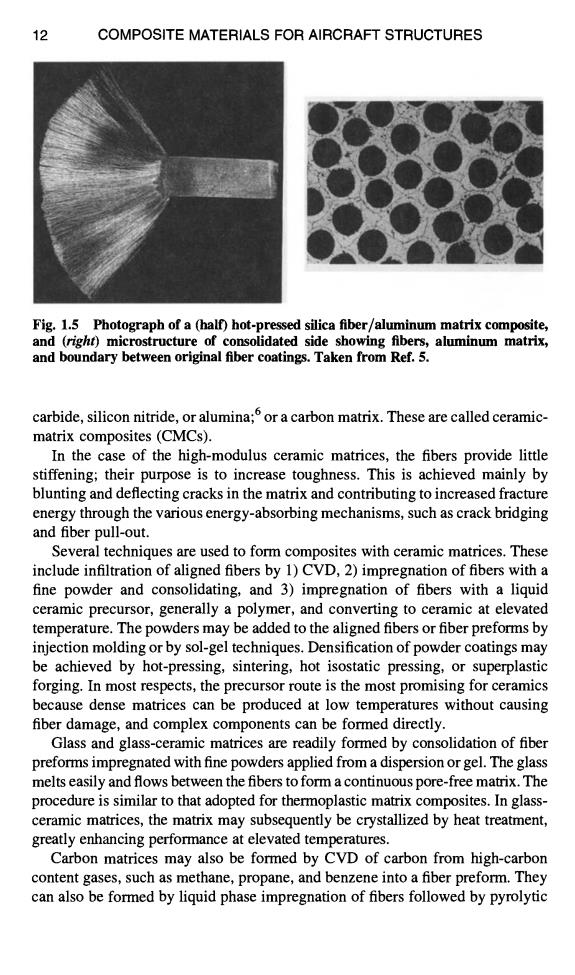正在加载图片...

12 COMPOSITE MATERIALS FOR AIRCRAFT STRUCTURES Fig.1.5 Photograph of a (half)hot-pressed silica fiber/aluminum matrix composite, and (right)microstructure of consolidated side showing fibers,aluminum matrix, and boundary between original fiber coatings.Taken from Ref.5. carbide,silicon nitride,or alumina;or a carbon matrix.These are called ceramic- matrix composites (CMCs). In the case of the high-modulus ceramic matrices,the fibers provide little stiffening;their purpose is to increase toughness.This is achieved mainly by blunting and deflecting cracks in the matrix and contributing to increased fracture energy through the various energy-absorbing mechanisms,such as crack bridging and fiber pull-out. Several techniques are used to form composites with ceramic matrices.These include infiltration of aligned fibers by 1)CVD,2)impregnation of fibers with a fine powder and consolidating,and 3)impregnation of fibers with a liquid ceramic precursor,generally a polymer,and converting to ceramic at elevated temperature.The powders may be added to the aligned fibers or fiber preforms by injection molding or by sol-gel techniques.Densification of powder coatings may be achieved by hot-pressing,sintering,hot isostatic pressing,or superplastic forging.In most respects,the precursor route is the most promising for ceramics because dense matrices can be produced at low temperatures without causing fiber damage,and complex components can be formed directly. Glass and glass-ceramic matrices are readily formed by consolidation of fiber preforms impregnated with fine powders applied from a dispersion or gel.The glass melts easily and flows between the fibers to form a continuous pore-free matrix.The procedure is similar to that adopted for thermoplastic matrix composites.In glass- ceramic matrices,the matrix may subsequently be crystallized by heat treatment, greatly enhancing performance at elevated temperatures. Carbon matrices may also be formed by CVD of carbon from high-carbon content gases,such as methane,propane,and benzene into a fiber preform.They can also be formed by liquid phase impregnation of fibers followed by pyrolytic12 COMPOSITE MATERIALS FOR AIRCRAFT STRUCTURES Fig. 1.5 Photograph of a (half) hot-pressed silica fiber/aluminum matrix composite, and (right) microstructure of consolidated side showing fibers, aluminum matrix, and boundary between original fiber coatings. Taken from Ref. 5. carbide, silicon nitride, or alumina; 6 or a carbon matrix. These are called ceramicmatrix composites (CMCs). In the case of the high-modulus ceramic matrices, the fibers provide little stiffening; their purpose is to increase toughness. This is achieved mainly by blunting and deflecting cracks in the matrix and contributing to increased fracture energy through the various energy-absorbing mechanisms, such as crack bridging and fiber pull-out. Several techniques are used to form composites with ceramic matrices. These include infiltration of aligned fibers by 1) CVD, 2) impregnation of fibers with a fine powder and consolidating, and 3) impregnation of fibers with a liquid ceramic precursor, generally a polymer, and converting to ceramic at elevated temperature. The powders may be added to the aligned fibers or fiber preforms by injection molding or by sol-gel techniques. Densification of powder coatings may be achieved by hot-pressing, sintering, hot isostatic pressing, or superplastic forging. In most respects, the precursor route is the most promising for ceramics because dense matrices can be produced at low temperatures without causing fiber damage, and complex components can be formed directly. Glass and glass-ceramic matrices are readily formed by consolidation of fiber preforms impregnated with fine powders applied from a dispersion or gel. The glass melts easily and flows between the fibers to form a continuous pore-free matrix. The procedure is similar to that adopted for thermoplastic matrix composites. In glassceramic matrices, the matrix may subsequently be crystallized by heat treatment, greatly enhancing performance at elevated temperatures. Carbon matrices may also be formed by CVD of carbon from high-carbon content gases, such as methane, propane, and benzene into a fiber preform. They can also be formed by liquid phase impregnation of fibers followed by pyrolytic